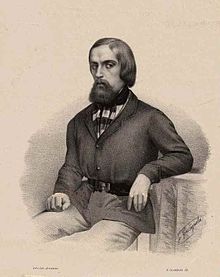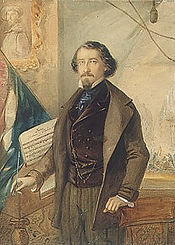- Il Canto degli Italiani
-
Il Canto degli Italiani English: The Song of the Italians 
Goffredo Mameli, author of the text of the Italian national anthem.
National anthem of
 Italy
Italy
Also known as Inno di Mameli
English: Mameli's Hymn
Fratelli d'Italia
English: Brothers of ItalyLyrics Goffredo Mameli, 1847 Music Michele Novaro, 1847 Adopted October 12, 1946 (de facto)
November 17, 2005 (de jure)Music sample Inno di Mameli (Instrumental) Michele Novaro, composer of the music
Michele Novaro, composer of the music
Il Canto degli Italiani (The Song of the Italians) is the Italian national anthem. It is best known among Italians as Inno di Mameli (Mameli's Hymn), after the author of the lyrics, or Fratelli d'Italia (Brothers of Italy), from its opening line.
The words were written in the autumn of 1847 in Genoa, by the then 20-year-old student and patriot Goffredo Mameli, in a climate of popular struggle for unification and independence of Italy which foreshadowed the war against Austria.
Two months later, they were set to music in Turin by another Genoese, Michele Novaro. The hymn enjoyed widespread popularity throughout the period of the Risorgimento and in the following decades.
After unification (1861) the adopted national anthem was the Marcia Reale, the Royal March (or Fanfara Reale), official hymn of the royal house of Savoy composed in 1831 to order of Carlo Alberto di Savoia. The Marcia Reale remained the Italian national anthem until the Italy became a republic in 1946.
Giuseppe Verdi, in his Inno delle Nazioni (Hymn of the Nations), composed for the London International Exhibition of 1862, chose Il Canto degli Italiani – and not the Marcia Reale – to represent Italy, putting it beside God Save the Queen and the Marseillaise.
In 1946 Italy became a republic, and on October 12, 1946, Il Canto degli Italiani was provisionally chosen as the country's new national anthem. This choice was made official in law only on November 17, 2005, almost 60 years later.
Contents
History
The first manuscript of the poem [2], preserved at the Istituto Mazziniano in Genoa, appears in a personal copybook of the poet, where he collected notes, thoughts and other writings. Of uncertain dating, the manuscript reveals anxiety and inspiration at the same time. The poet begins with È sorta dal feretro (It's risen from the bier) then seems to change his mind: leaves some room, begins a new paragraph and writes "Evviva l'Italia, l'Italia s'è desta" (Hurray Italy, Italy has awakened). The handwriting appears nervy and frenetic, with numerous spelling errors, among which are "Ilia" for "Italia" and "Ballilla" for "Balilla".
The last strophe is deleted by the author, to the point of being barely readable. It was dedicated to Italian women:
-
- Italian
- Tessete o fanciulle
- bandiere e coccarde
- fan l'alme gagliarde
- l'invito d'amor.
-
-
-
-
- English
- Weave o maidens
- flags and cockades
- make souls gallant
- the invitation of love.
-
-
-
The second manuscript is the copy that Mameli sent to Novaro for setting to music. It shows a much steadier handwriting, fixes misspellings, and has a significant modification: the incipit is "Fratelli d'Italia". This copy is in the Museo del Risorgimento in Turin.
The hymn was also printed on leaflets in Genoa, by the printing office Casamara. The Istituto Mazziniano has a copy of these, with hand annotations by Mameli himself. This sheet, subsequent to the two manuscripts, lacks the last strophe ("Son giunchi che piegano...") for fear of censorship. These leaflets were to be distributed on the December 10 demonstration, in Genoa.
December 10, 1847 was an historical day for Italy: the demonstration was officially dedicated to the 101st anniversary of the popular rebellion which led to the expulsion of the Austrian powers from the city; in fact it was an excuse to protest against foreign occupations in Italy and induce Carlo Alberto to embrace the Italian cause of liberty. In this occasion the tricolor flag was shown and Mameli's hymn was publicly sung for the first time.
After December 10 the hymn spread all over the Italian peninsula, brought by the same patriots that participated to the Genoa demonstration.
Lyrics
This is the complete text of the original poem written by Goffredo Mameli; however the Italian anthem, as performed in every official occasion, is composed of the first stanza, sung twice, and the chorus, then ends with a loud "Sì!" ("Yes!"). The third stanza is an invocation to God to protect the loving union of the Italians struggling to form their unified nation once and for all, the fourth recalls popular heroic figures and moments of Italian independence such as the Vespri siciliani, the riot started in Genoa by Balilla and the battle of Legnano. The last stanza of the poem refers to the part played by Habsburg Austria and Czarist Russia in the partitions of Poland, linking its quest for independence to the Italian one.
- Italian lyrics
- Fratelli d'Italia,
- l'Italia s'è desta,
- dell'elmo di Scipio
- s'è cinta la testa.
- Dov'è la Vittoria?
- Le porga la chioma,
- ché schiava di Roma
- Iddio la creò.
-
-
- CORO:
- Stringiamci a coorte,
- siam pronti alla morte.
- Siam pronti alla morte,
- l'Italia chiamò.
- Stringiamci a coorte,
- siam pronti alla morte.
- Siam pronti alla morte,
- l'Italia chiamò, sì!
-
-
- Noi fummo da secoli[1]
- calpesti, derisi,
- perché non siam popolo,
- perché siam divisi.
- Raccolgaci un'unica
- bandiera, una speme:
- di fonderci insieme
- già l'ora suonò.
-
-
- CORO
-
-
- Uniamoci, amiamoci,
- l'unione e l'amore
- rivelano ai popoli
- le vie del Signore.
- Giuriamo far libero
- il suolo natio:
- uniti, per Dio,
- chi vincer ci può?
-
-
- CORO
-
-
- Dall'Alpi a Sicilia
- dovunque è Legnano,
- ogn'uom di Ferruccio
- ha il core, ha la mano,
- i bimbi d'Italia
- si chiaman Balilla,
- il suon d'ogni squilla
- i Vespri suonò.
-
-
- CORO
-
-
- Son giunchi che piegano
- le spade vendute:
- già l'Aquila d'Austria
- le penne ha perdute.
- Il sangue d'Italia,
- il sangue Polacco,
- bevé, col cosacco,
- ma il cor le bruciò.
-
-
- CORO
-
-
-
-
-
- We were for centuries
- downtrodden, derided,
- because we are not one people,
- because we are divided.
- Let one flag, one hope
- gather us all.
- The hour has struck
- for us to unite.
-
-
-
-
-
-
-
-
- CHORUS
-
-
-
-
-
-
-
-
- Let us unite, let us love one another,
- For union and love
- Reveal to the people
- The ways of the Lord.
- Let us swear to set free
- The land of our birth:
- United, for God,
- Who can overcome us?
-
-
-
-
-
-
-
-
- CHORUS
-
-
-
-
-
-
-
-
-
- CHORUS
-
-
-
-
-
-
-
-
- Mercenary swords,
- they're feeble reeds.
- The Austrian eagle
- Has already lost its plumes.
- The blood of Italy
- and the Polish blood
- It drank, along with the Cossack,
- But it burned its heart.
-
-
-
-
-
-
-
-
- CHORUS
-
-
-
-
Audio
Notes
- ^ A different tense may be found: Noi siamo da secoli, "We have been for centuries".
- ^ Le porga la chioma literally translates as "Let her offer her locks to [Italy]", a possible reference to the ancient custom of slaves cutting their hair short as a sign of servitude. (See [1])
- ^ Siam pronti alla morte may be understood both as an indicative ("We are ready to die") and as an imperative ("Let us be ready to die").
External links
- Free sheet music of Il Canto degli Italiani from Cantorion.org
- From Quirinale, residence of the Head of State, various recorded performances
(in Italian - to listen to music click on "ascolta l'inno" on the various formats) - Italian national anthem Italian to English poetic translation.
National anthems of Europe National anthems
of sovereign statesAlbania · Andorra · Armenia · Austria · Azerbaijan · Belarus · Belgium · Bosnia and Herzegovina · Bulgaria · Croatia · Cyprus · Czech Republic · Denmark · Estonia · Finland · France · Georgia · Germany · Greece · Hungary · Iceland · Ireland · Italy · Kazakhstan · Latvia · Liechtenstein · Lithuania · Luxembourg · Macedonia · Malta · Moldova · Monaco · Montenegro · Netherlands · Norway · Poland · Portugal · Romania · Russia · San Marino · Serbia · Slovakia · Slovenia · Spain · Sweden · Switzerland · Turkey · Ukraine · United Kingdom · Vatican City
National and regional
anthems of other
political entitiesAbkhazia (disputed) · Adygea (Russia) · Åland (Finland) · Asturias (Spain) · Bashkortostan (Russia) · Basque Country (Spain) · Bavaria (Germany) · Brittany (France) · Catalonia (Spain) · Chechen Republic (Russia) · Dagestan Republic (Russia) · Cornwall (UK) · Corsica (France) · Crimea (Ukraine) · England (UK) · Faroe Islands (Denmark) · Flanders (Belgium) · Friesland (Netherlands) · Gibraltar (UK) · Greenland (Denmark) · Guernsey · Istria (Croatia) · Northern Ireland (UK) · Jersey · Republic of Karelia (Russia) · Komi Republic (Russia) · Kosovo (disputed) · Lincolnshire (UK) · Lusatia (Germany) · Macedonia (Greece) · Isle of Man · Mari El (Russia) · Mordovia (Russia) · Nagorno-Karabakh (disputed) · North Ossetia-Alania (Russia) · Republika Srpska (Bosnia and Herzegovina) · Sami · Scotland (UK) · South Ossetia (disputed) · Svalbard (Norway) · Tatarstan (Russia) · Transnistria (disputed) · Northern Cyprus (disputed) · Tuva (Russia) · Udmurtia (Russia) · Valencia (Spain) · Wales (UK) · Wallonia (Belgium) · Yorkshire (UK)
Anthems of former
political entitiesAlsace (German Empire) · German Democratic Republic (East Germany) · Soviet Union (1944-1991) · SFR Yugoslavia (1977-1991) · FR Yugoslavia (1992-2003) · Serbia and Montenegro (2003-2006) Second Spanish Republic (1931-1939)
Anthem of
European Union and
Council of EuropeComplete List · Africa · Asia · Europe · North America · Oceania and the Pacific Islands · South AmericaCategories:- 1847 songs
- National anthems
- Italian culture
- National symbols of Italy
- Italian patriotic songs
- Italy–Poland relations
-
Wikimedia Foundation. 2010.
